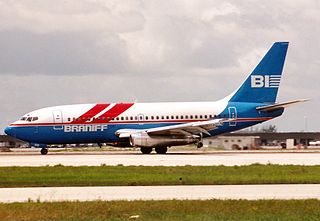This is a list of aviation-related events from 1983.

TAME or TAME EP Linea Aerea del Ecuador was an airline founded in Ecuador in 1962. TAME was the flag carrier and the largest airline of Ecuador. TAME headquarters were in Quito, Pichincha Province and the main hub was Mariscal Sucre International Airport in Quito. The airline was formed by the Air Force of Ecuador. In 2011, it became a commercial entity and provided domestic, international and charter flights. On May 20, 2020, the Ecuador government decided to cease all the operations and liquidate the airline.

Faucett Perú Flight 251 refers to a Boeing 737-200 that was operating a domestic scheduled Lima–Arequipa–Tacna passenger service and crashed on 29 February 1996, while completing the first leg, on approach to Rodríguez Ballón International Airport. All 123 passengers and crew aboard the aircraft lost their lives in the accident. It is the deadliest aviation accident that occurred on Peruvian soil.

Swiftair S.A. is an airline whose headquarters are in Madrid, Spain. It operates scheduled and charter, passenger and cargo flights in Europe, North Africa and the Middle East. Its main base is Madrid–Barajas Airport.

Icaro Air was an airline based in Quito, Ecuador. Its main base was Mariscal Sucre International Airport, Quito.
Aerosucre S.A. is a cargo airline based in Bogotá, Colombia. It began operation in 1969 and operates scheduled international and domestic cargo services throughout Latin America and the Caribbean. Its home base is El Dorado International Airport, Bogotá. Aerosucre has been involved in a number of accidents and incidents during its lifetime, and more recently, internet videos have emerged showcasing reckless behavior by its pilots.

Mariscal Sucre International Airport(IATA: UIO, ICAO: SEQU) was the main international airport that served Quito, Pichincha, Ecuador. It was the busiest airport in Ecuador by passenger traffic, by aircraft movement and by cargo movement, and one of the busiest airports in South America. It was named after Venezuelan-born Antonio José de Sucre, a hero of Ecuadorian and Latin American independence. It began operations on August 5, 1960, and during its last years of operation, handled about 6.2 million passengers and 164,000 metric tons of freight per year. The airport, one of the highest in the world was located in the northern part of the city, in the Chaupicruz parish, within five minutes of Quito's financial center; the terminals were located at the intersection of Amazonas and La Prensa avenues. Mariscal Sucre International was the largest hub for TAME with an average of 50 daily departures.

Copa Airlines Flight 201 was a regularly scheduled passenger flight from Tocumen International Airport in Panama City, Panama, to Alfonso Bonilla Aragón International Airport in Cali, Colombia. On 6 June 1992, the Boeing 737-204 Advanced operating the route rolled, entered a steep dive, disintegrated in mid-air, and crashed into the jungle of the Darién Gap 29 minutes after takeoff, killing all 47 people on board. The in-flight break-up was caused by faulty instrument readings and several other contributing factors, including incomplete training.
SAETA Air Ecuador was a privately held airline of Ecuador, which was founded in 1966. During its heyday in the 1990s, it flew to numerous destinations in North and South America from its base in Guayaquil.

Mariscal Lamar International Airport is a high elevation airport serving Cuenca, the capital of the Azuay Province in Ecuador. It is named after the Peruvian military leader and politician José de la Mar, a native of Cuenca.

On June 9, 1996, while operating a passenger flight from Trenton, New Jersey to Richmond, Virginia, the crew of Eastwind Airlines Flight 517 temporarily lost control of their Boeing 737-200 because of a rudder malfunction. The crew were able to regain control and land the aircraft successfully. One flight attendant was injured.
Trigana Air is an airline based in Jakarta, Indonesia.
SAN was an airline which was based in Guayaquil, Ecuador that was the domestic branch of the airline SAETA. It was founded in 1964, and ceased operations in 1999.

Turkish Airlines Flight 278, operated by a Boeing 737-4Y0 registered TC-JES and named Mersin, was a domestic scheduled flight from Ankara Esenboğa Airport to Van Ferit Melen Airport in eastern Turkey that crashed on 29 December 1994 during its final approach to land in driving snow. Five of the seven crew and 52 of the 69 passengers lost their lives, while two crew members and 17 passengers survived with serious injuries.
Ricaurte is a town and parish in Cuenca Canton, Azuay Province, Ecuador. The parish covers an area of 14.3 km² and according to the 2001 Ecuadorian census it had a population total of 14,006.
In aeronautics, loss of control (LOC) is the unintended departure of an aircraft from controlled flight and is a significant factor in several aviation accidents worldwide. In 2015 it was the leading cause of general aviation accidents. Loss of control may be the result of mechanical failure, external disturbances, aircraft upset conditions, or inappropriate crew actions or responses.

Tatarstan Airlines Flight 363 was a scheduled domestic passenger flight, operated by Tatarstan Airlines on behalf of Ak Bars Aero, from Moscow to Kazan, Russia. On 17 November 2013, at 19:24 local time (UTC+4), the Boeing 737-500 crashed during an aborted landing at Kazan International Airport, killing all 44 passengers and 6 crew members on board, making it 2013's worst plane crash.










